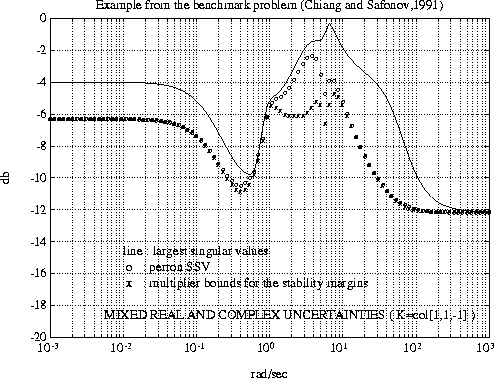

| Robust Control Toolbox |   |
Compute the structured singular value (multivariable stability margin) Bode plot.
[mu,logd] = ssv(a,b,c,d,w) [mu,logd] = ssv(a,b,c,d,w,k) [mu,logd] = ssv(a,b,c,d,w,k,opt) [mu,logd] = ssv(ss,)
Description
ssv produces the row vector mu containing an upper bound on the structured singular value (SSV) of p x q a transfer function matrix 
 .
Several methods are included via the following input options:
.
Several methods are included via the following input options:
opt -- options for method used in computing SSV:
'osborne' Osborne method
'psv' optimal diagonal scaled Perron eigenvalue (default)
'perron' Perron eigenvalue (if only mu output specified).
'muopt' Multiplier approach for pure real, pure complex and mixed real/complex uncertainties. If there exists real uncertainty, 'muopt' will be used (default for systems with mixed uncertainty).
k -- uncertainty block sizes (default: k=ones(q,2)); k can be an n x 1 or n x 2 matrix whose rows are the uncertainty block sizes for which the SSV is to be evaluated. If only the first column of k is given, then the uncertainty blocks are taken to be square, as if k(:,1) = k(:,2). If a 1 x 1 uncertainty block is real (say, the ith block), then you should assign
k(i,:) = [-1, -1];and set the input argument
opt to 'muopt' to invoke the multiplier nonlinear programming algorithm to compute a less conservative SSV upper bound.
The output variables are:
mu -- the Bode plot of the SSV
logd -- the log Bode plot of the optimal diagonal scaling D(j ). When the uncertainties are all complex, then D(j
). When the uncertainties are all complex, then D(j ) is purely real; this is always the case for the
) is purely real; this is always the case for the opt = 'psv' or opt = 'muopt' options. If opt = 'muopt' and the uncertainty is of the mixed real/complex type, logd in general will be complex and will contain the log Bode plot of the squareroots of the optimal multiplier scalings.
Algorithm
ssv performs its computation using either perron, psv, osborne, or muopt depending of the value of option. All of them can handle the irreducible special case where the standard algorithms fail. See the documentation for these functions for further details.
Examples
This example compares all the methods available in the Robust Control Toolbox for a less conservative multivariable stability margin prediction. The transfer function  seen by the real uncertainties is the one established in ACC Benchmark problem [4], which can be extracted from the demo
seen by the real uncertainties is the one established in ACC Benchmark problem [4], which can be extracted from the demo accdemo.m. As shown in Figure 1-16, the multiplier solution provides the least conservative result, as compared to Perron and Osborne.

Figure 1-16: Comparison of Robust Analysis Methods.
See Also
muopt, perron, psv, osborne
References
[1] E. E. Osborne, "On Preconditioning of Matrices,'' J. of Assoc. of Computing Machinery, vol. 7, pp. 338-345, March 1960.
 | sfl, sfr | stabproj, slowfast |  |